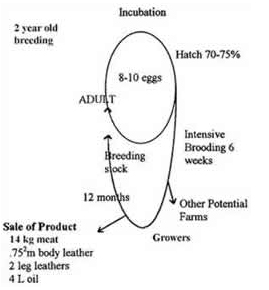
Figure 1. Emu production cycle
Farm plan
You will need an individual farm plan for your new enterprise. When drawing up your plan, consult information about stocking densities, facility requirements and any legal requirements or codes of practice. Visits to other emu farms can give you a variety of ideas.
If you are going to breed emus and conduct intensive rearing, you will need to provide egg handling, storage, incubation and hatching facilities as well as a brooder house for chicks and rearing pens for young birds.
If breeding and rearing free-range emus you will need extra pens to allow females to be removed while the male is sitting on the eggs. This will also keep broody males isolated from other birds. Interference by other emus can result in egg damage and chick loss. Under free-range systems, additional pens may be required so that the chicks remain isolated from other older birds.
Aspects of Husbandry and Production
Emu production cycle (see Figure 1)
Feeding
A special diet similar to poultry feed specifications, supplemented with farm-grown lucerne and other pasture, is fed at each of the different stages of growth.
Health and disease
Emus contract similar diseases to poultry, and emu chicks up the the age of three months have a mortality rate of 7-12%. There is little information at this time on specific emu diseases.
Average production figures
These figures are a guide only:
- age at sexual maturity: 2 years
- number of eggs/year: first year breeders 8-12; under artificial incubation 16-24
- male to female breeding ratio: 1:1 or 1:2
- important weights:
- hatch 420 g
- three months 8 kg
- six months 19 kg
- 1 year 30 kg (slaughter age)
- 2 years: 50 kg (breeding age).


